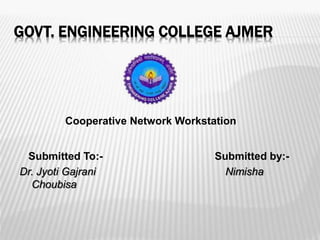
Optimize Corporate Networks with Cisco Packet Tracer
- 1. GOVT. ENGINEERING COLLEGE AJMER Submitted To:- Submitted by:- Dr. Jyoti Gajrani Nimisha Choubisa Cooperative Network Workstation 1
- 2. INTRODUCTION : – WHAT DOES CORPORATE NETWORK MEAN? 1) An corporative network is an corporate communications backbone that helps connect computers and related devices across departments and workgroup networks, facilitating insight and data accessibility. 2) A corporate network reduces communication protocols, facilitating system and device interoperability, as well as improved internal and external enterprise data management. 2
- 3. CORPORATE NETWORK :- WHY? The key purpose of a corporate network is to eliminate isolated users and workgroups. All systems should be able to communicate and provide and retrieve information. Additionally, physical systems and devices should be able to maintain and provide satisfactory performance, reliability and security. In scope, an corporate network may include local and wide area networks (LAN/WAN), depending on operational and departmental requirements. A corporate network can integrate all systems, including Windows and Apple computers and operating systems (OS), Unix systems, mainframes and related devices like smart phones and tablets. 3
- 4. Increase Profits and Real-time access from anywhere to the social information shared within the company. Analyze interactions within the organization through network analysis tools. Integrate business tools and create communication between people and objects . Connect the various software used in company to the corporative Network. Keep up-to-date with all the activities done by those tools in real time side the company. Create an “idea market” on to communicate with employees through open groups that could also involve people from outside company. Create workflows and tasks assignment around documents and conversations. . 4
- 5. Corporative Networks drive strategic business objectives. They help to improve management processes in different departments. Their benefits are translated into business that affect processes, sales, customer management, human resources, knowledge management, and even improve productivity across the board in all members of the company 1 - Update status to let others know on what you are working on. 2- Create exchange groups on specific skills and for knowledge transfer A Corporate Network helps put expertise forward :- The Corporative Network as the vehicle of corporate culture :- 1 - Develop community engagement and agitation with communication management. 2 - Quickly redefine the organization through the creation of groups and departments in the network. 5
- 6. Two ways an Corporative Network can improve processes :- 1 - Manage communication flows through groups, private messaging, micro blogging, notifications instead of emails. 2 - Create workflows and tasks assignment around documents and conversations and involve external people as well as external information into the processes. Conversations are not only about humans, it is also a matter of tools :- 1 - Connect the various software used in your company to the Enterprise Social Network. 2 - Structure the flow of information in one single activity feed. 3 - Keep up-to-date with all the activities done by those tools in real time. 6
- 7. Logical and physical workspaces The logical workspace allows student to get a global view of the network through real time or simulation mode. The devices are added, linked, and configured on this workspace. The physical workspace gives a physical dimension to the logical network topology. This workspace is particularly important for wireless labs, where the distance parameter is one of the factors that determine if a device is able to connect or not connect to another device. The physical workspace is divided into four layers to reflect the physical scale of real life environments: Intercity, City, Building, Wiring Closet. 7
- 8. TOOL USED: CISCO PACKET TRACER Packet Tracer is a protocol simulator developed at Cisco Systems. Packet Tracer (PT) is a powerful and dynamic tool that displays the various protocols used in networking, in either Real Time or Simulation mode. This includes layer 2 protocols such as Ethernet and PPP, layer 3 protocols such as IP, ICMP, and ARP, and layer 4 protocols such as TCP and UDP. Routing protocols can also be traced. Packet Tracer is a supplement to and not a replacement for experience with real equipment. 8
- 9. 9
- 10. Supported Protocols :- LAN: Ethernet (including CSMA/CD), 802.11 a/b/g/n wireless, PPPOE Switching: VLANs, 802.1q, trunking, VTP, DTP, STP, RSTP, multilayer switching, Etherchannel, LACP, PAgP TCP/IP: HTTP, HTTPS, DHCP, DHCPv6, Telnet, SSH, TFTP, DNS, TCP, UDP, IPv4, IPv6, ICMP, ICMPv6, ARP, IPv6 ND, FTP, SMTP, POP3, VOIP(H.323) Routing: static, default, RIPv1, RIPv2, EIGRP, single-area OSPF, multi-area OSPF, BGP, inter-VLAN routing, redistribution Other: ACLs (standard, extended, and named), CDP, NAT (static, dynamic, inside/outside, and overload), NATv6 WAN: HDLC, SLARP, PPP, and Frame Relay Security: IPsec, GRE, ISAKMP, NTP, AAA, RADIUS, TACACS, SNMP, SSH, SYSLOG, CBAC, Zone-based policy firewall, IPS QoS: Layer 2 QoS, Layer 3 Diffserv QoS, FIFO Hardware queues, Priority Queuing, Custom Queuing, Weighted Fair Queuing, MQC, NBAR 10
- 11. Analyze interactions within the organization through network analysis tools. Integrate business tools and create communication between people and objects The logical workspace allows student to get a global view of the network through real time or simulation mode 11
- 12. 12
